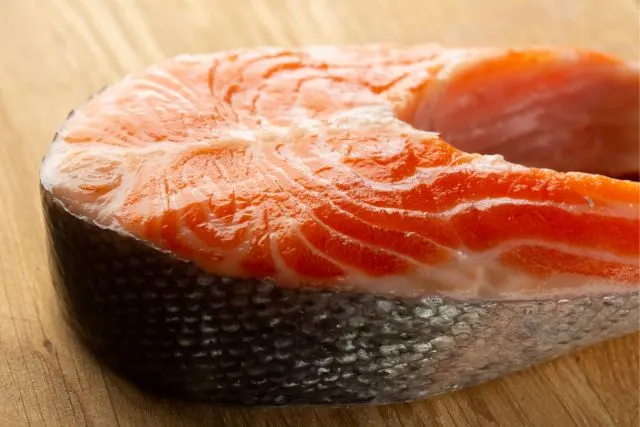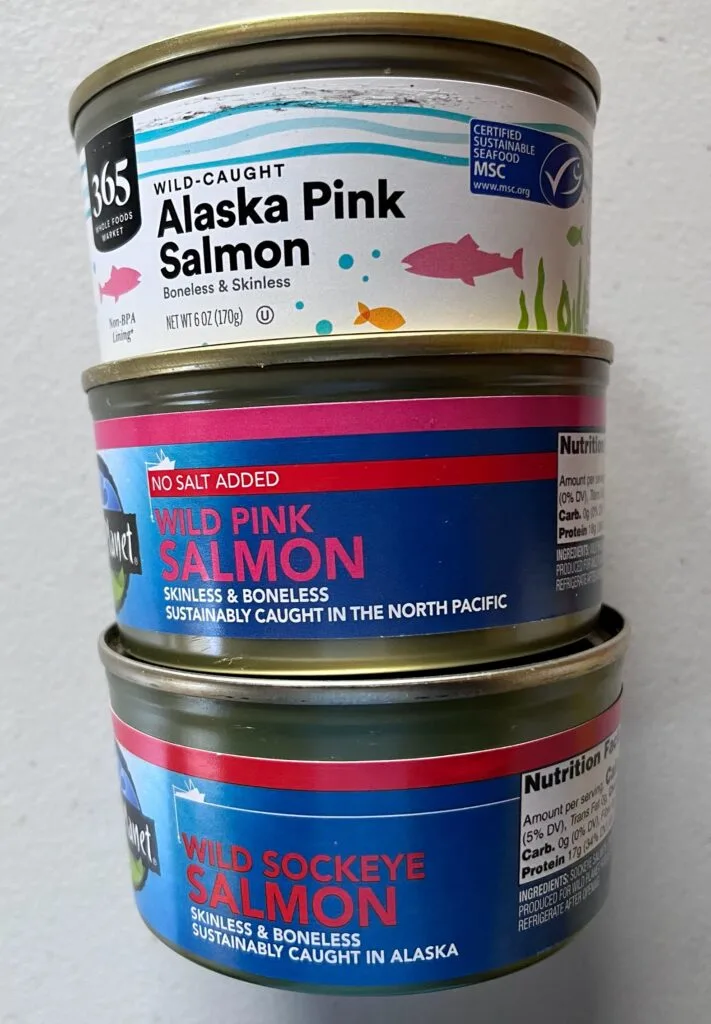When you want to eat healthy but don’t have much time, it’s convenient to reach for a can of salmon. But does canned salmon have the same health benefits as fresh salmon?
This is something I have wondered about myself. So I am going to be comparing canned and fresh salmon side-by-side to see which one is a healthier option. I will compare everything from nutrition to availability.

There is a variety of salmon that is canned but for the sake of this comparison, I will be comparing pink salmon. Pink salmon is the most common salmon that is canned.
A can of tuna that has been drained is roughly 113 grams while a serving size of fresh salmon is 150 grams. Since our two contestants differ slightly in serving size, I will do a weight-for-weight comparison of 100 grams for each.
Nutritional Comparison
First up is the nutritional comparison. We’ve all heard how healthy fish is for us but just how healthy is it? And is fresh salmon healthier than canned salmon?
Fresh salmon is lower in calories than canned salmon but it makes up for it with a high sodium content. Canned salmon is 300 times higher in sodium than fresh salmon.
You can reduce the amount of sodium in canned salmon by draining the salmon and then rinsing it with water. The sodium content will still be higher than fresh salmon but it will drastically reduce the amount of sodium you consume.
Nutrition Type |
Canned Pink Salmon (100g) |
Fresh Pink Salmon (100g) |
|
Calories |
138 kcal |
127 kcal |
|
Protein |
23.1g |
20.5g |
|
Sodium |
381mg |
75mg |
When it comes to fat content, we really need to look closer at the type of fat in salmon. Not all fat is created equal. Monounsaturated and polyunsaturated fats are healthy fats. Both of these fats have tremendous health benefits for our heart, skin, and even our digestive system.
Both fresh and canned salmon have good amounts of healthy fat, but canned salmon has higher amounts than fresh salmon, again, most likely due to the fact that the bones are “cooked” in canned salmon meat.
Fat Type |
Canned Pink Salmon (100g) |
Fresh Pink Salmon (100g) |
|
Overall Fat Content |
5.02 g |
4.4 g |
|
Monounsaturated Fat |
1.21 g |
1.35 g |
|
Polyunsaturated Fat |
1.51 g |
0.811 g |
Salmon does not have any carbohydrates, fiber, or sugar but it is loaded with vitamins and minerals. The chart below is not a comprehensive list but it gives you the highlights.
Canned salmon has a higher nutritional content than fresh salmon. Canned salmon has higher amounts of calcium and vitamins E and D.
Canned salmon has almost over 200 times more calcium than fresh pink salmon. The reason for this is that canned salmon is “cooked” with the bones still in the fish. This allows the calcium from the bones to get into the ‘meat’.
Nutrition Type |
Canned Pink Salmon (100g) |
Fresh Pink Salmon (100g) |
|
Calcium |
283 mg |
7 mg |
|
Iron |
0.77g |
0.38g |
|
Magnesium |
32 mg |
27 mg |
|
Phosphorous |
379 mg |
261 mg |
|
Potassium |
33mg |
366 mg |
|
Zinc |
0.96 mg |
0.39 mg |
|
Selenium |
39.5 µg (mcg) |
31.4 µg (mcg) |
|
Niacin |
7.41 mg |
8 mg |
|
Vitamin B12 |
4.95 µg (mcg) |
4.15 µg (mcg) |
|
Vitamin A |
65 IU |
117 IU |
|
Vitamin E |
1.28 mg |
0.4 mg |
|
Vitamin D |
580 IU |
435 IU |

Mercury Content
Next to fat, mercury content is probably the most asked question regarding any type of fish. Mercury is found in all seafood, thanks to global warming and pollution. As fish eat, swim, and eat other fish, the amount of mercury in their system will rise.
Salmon is low on the fish-eating-fish food chain so the amount of mercury in salmon is lower than, say, in tuna. But the amount is still something we need to be concerned about. Consuming too much mercury is dangerous to our overall health, especially to women who are pregnant, breastfeeding, and infants.
So which contains less mercury, canned or fresh salmon? Canned salmon contains more mercury than fresh salmon. The higher amount of mercury in canned salmon is largely due to the type of salmon caught.
Farm-raised salmon will often have higher amounts of mercury because the fish have been subjected to pesticides. Carefully read the label and do your research to find out which type of salmon you’re buying.
Type of Salmon |
Mercury Content Per 100g Serving |
|
Canned Pink Salmon |
2.5 g |
|
Fresh Pink Salmon |
1.52 g |
Uses Comparison
At the end of the day, our choice to eat canned or fresh salmon may simply come down to time. Which is easier to cook with, canned salmon or fresh salmon?
Both canned and fresh salmon are versatile to cook with but canned salmon is quicker to use since it is already “cooked”. Simply drain off the liquid, remove the skin and it is ready to be eaten on its own or turned into a meal.
Removing the skin is a personal preference, however, depending on the type of salmon that was canned, farm-raised salmon will have higher amounts of pesticides and mercury in the skin.
The bones, though, have been heated and are no longer sharp. Simply mash them with a fork and you will never know they are there. It’s also a great way to get a calcium boost!
Since canned salmon is already “cooked”, it has an extended shelf life. Keep canned salmon on hand for those times when you are busy but want a healthy meal. Here are some suggestions for using canned salmon.
- Salmon Patties – mix a can of salmon (with skin removed) with one whole egg. Form into a pattie and roll in crushed crackers. Lightly fry the patties in a skillet with olive oil or in an air fryer, about 3 minutes per side.
- Pasta – simply mix a can of salmon with any cooked pasta. Top with olives and grated parmesan cheese.
- Add it to any salad to increase the protein and healthy fat content.
Fresh salmon takes a little to cook but it is just as versatile as canned salmon. You can use fresh salmon to make salmon tacos, sushi, even salmon steaks.
Flavor/Texture Comparison
I need your help. With this category of taste, I’m doing a poll between canned and fresh salmon. Please vote below and share your preference. The current tally will be revealed after your submission. (no personal information required)
Both canned and fresh salmon are comparable when it comes to flavor and texture. The biggest difference is the sodium content in canned salmon. Otherwise, both are mild in flavor and have a flaky texture.
Storage and Availability
Canned salmon is available at just about every store that sells food. They are often found right next to the tuna. You can find the salmon in a wide variety of flavors and now you can buy it in pouches that make it easier to eat when you’re on the run.

Canned salmon has a long shelf life, making it great for stocking your pantry. You can always have healthy salmon on hand. It also works well as part of your emergency supplies. Since it is already “cooked”, there is no heating, cooking, or cooling required.
Fresh salmon may be more difficult to find. It all depends on where you live. Most large grocery chains will carry fresh salmon but this may not be an option if you live in a smaller town. You can buy fresh salmon online but it can be costly.
Fresh salmon needs to be frozen or cooked immediately. It should not be left in the refrigerator for more than a day. And never eat salmon that smells fishy. A fishy smell is a sure sign the salmon has been warmed and cooled a number of times.
Related Articles
Canned Asparagus Vs. Fresh (Which is Best)
Smarties Vs. M&M’s (What’s the Difference?)
Frosted Mini-Wheats Vs. Cheerios (Which is Best?)
